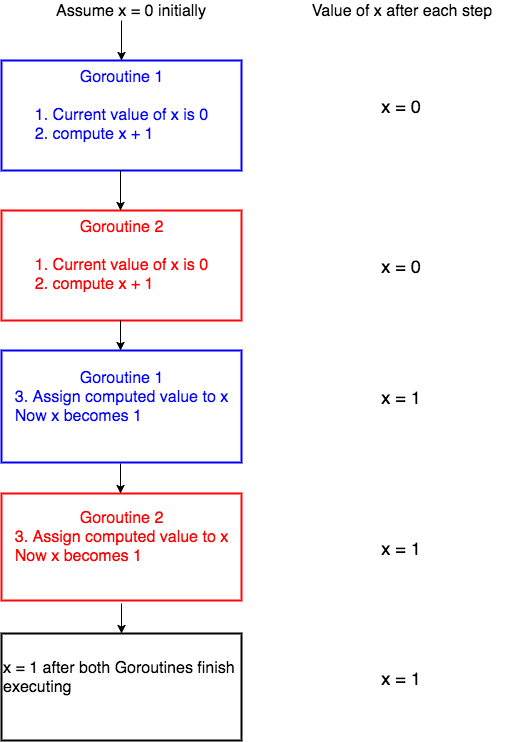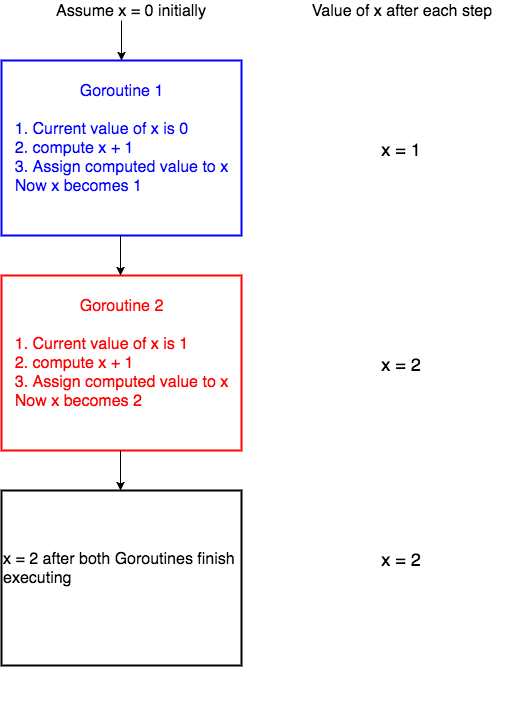Go Mutex Tutorial
Welcome to tutorial no. 25 in Golang tutorial series.
In this tutorial, we will learn about mutexes. We will also learn how to solve race conditions using mutexes and channels.
Critical section
Before jumping to mutex, it is important to understand the concept of critical section in concurrent programming. When a program runs concurrently, the parts of code which modify shared resources should not be accessed by multiple Goroutines at the same time. This section of code that modifies shared resources is called critical section. For example, let’s assume that we have some piece of code that increments a variable x by 1.
x = x + 1
As long as the above piece of code is accessed by a single Goroutine, there shouldn’t be any problem.
Let’s see why this code will fail when there are multiple Goroutines running concurrently. For the sake of simplicity let’s assume that we have 2 Goroutines running the above line of code concurrently.
Internally the above line of code will be executed by the system in the following steps(there are more technical details involving registers, how addition works, and so on but for the sake of this tutorial lets assume that these are the three steps),
- get the current value of x
- compute x + 1
- assign the computed value in step 2 to x
When these three steps are carried out by only one Goroutine, all is well.
Let’s discuss what happens when 2 Goroutines run this code concurrently. The picture below depicts one scenario of what could happen when two Goroutines access the line of code x = x + 1 concurrently.

We have assumed the initial value of x to be 0. Goroutine 1 gets the initial value of x, computes x + 1 and before it could assign the computed value to x, the system context switches to Goroutine 2. Now Goroutine 2 gets the initial value of x which is still 0, computes x + 1. After this, the system context switches again to Goroutine 1. Now Goroutine 1 assigns its computed value 1 to x and hence x becomes 1. Then Goroutine 2 starts execution again and then assigns its computed value, which is again 1 to x and hence x is 1 after both Goroutines execute.
Now let’s see a different scenario of what could happen.

In the above scenario, Goroutine 1 starts execution and finishes all its three steps and hence the value of x becomes 1. Then Goroutine 2 starts execution. Now the value of x is 1 and when Goroutine 2 finishes execution, the value of x is 2.
So from the two cases, you can see that the final value of x is 1 or 2 depending on how context switching happens. This type of undesirable situation where the output of the program depends on the sequence of execution of Goroutines is called race condition.
In the above scenario, the race condition could have been avoided if only one Goroutine was allowed to access the critical section of the code at any point in time. This is made possible by using Mutex.
Mutex
A Mutex is used to provide a locking mechanism to ensure that only one Goroutine is running the critical section of code at any point in time to prevent race conditions from happening.
Mutex is available in the sync package. There are two methods defined on Mutex namely Lock and Unlock. Any code that is present between a call to Lock and Unlock will be executed by only one Goroutine, thus avoiding race condition.
1mutex.Lock()
2x = x + 1
3mutex.Unlock()
In the above code, x = x + 1 will be executed by only one Goroutine at any point in time thus preventing race condition.
If one Goroutine already holds the lock and if a new Goroutine is trying to acquire a lock, the new Goroutine will be blocked until the mutex is unlocked.
Program with a race condition
In this section, we will write a program which has race condition and in the upcoming sections, we will fix the race condition.
1package main
2import (
3 "fmt"
4 "sync"
5 )
6var x = 0
7func increment(wg *sync.WaitGroup) {
8 x = x + 1
9 wg.Done()
10}
11func main() {
12 var w sync.WaitGroup
13 for i := 0; i < 1000; i++ {
14 w.Add(1)
15 go increment(&w)
16 }
17 w.Wait()
18 fmt.Println("final value of x", x)
19}
In the program above, the increment function in line no. 7 increments the value of x by 1 and then calls Done() on the WaitGroup to notify its completion.
We spawn 1000 increment Goroutines from line no. 15 of the program above. Each of these Goroutines run concurrently and the race condition occurs when trying to increment x is line no. 8 as multiple Goroutines try to access the value of x concurrently.
Please run this program in your local as the playground is deterministic and the race condition will not occur in the playground. Run this program multiple times in your local machine and you can see that the output will be different for each time because of race condition.
Some of the outputs which I encountered are final value of x 941, final value of x 928, final value of x 922 and so on.
Solving the race condition using a mutex
In the program above, we spawn 1000 Goroutines. If each increments the value of x by 1, the final desired value of x should be 1000. In this section, we will fix the race condition in the program above using a mutex.
1package main
2import (
3 "fmt"
4 "sync"
5 )
6var x = 0
7func increment(wg *sync.WaitGroup, m *sync.Mutex) {
8 m.Lock()
9 x = x + 1
10 m.Unlock()
11 wg.Done()
12}
13func main() {
14 var w sync.WaitGroup
15 var m sync.Mutex
16 for i := 0; i < 1000; i++ {
17 w.Add(1)
18 go increment(&w, &m)
19 }
20 w.Wait()
21 fmt.Println("final value of x", x)
22}
Mutex is a struct type and we create a zero valued variable m of type Mutex in line no. 15. In the above program we have changed the increment function so that the code which increments x x = x + 1 is between m.Lock() and m.Unlock(). Now this code is void of any race conditions since only one Goroutine is allowed to execute this piece of code at any point in time.
Now if this program is run, it will output
final value of x 1000
It is important to pass the address of the mutex in line no. 18. If the mutex is passed by value instead of passing the address, each Goroutine will have its own copy of the mutex and the race condition will still occur.
Solving the race condition using channel
We can solve the race condition using channels too. Let’s see how this is done.
1package main
2import (
3 "fmt"
4 "sync"
5 )
6var x = 0
7func increment(wg *sync.WaitGroup, ch chan bool) {
8 ch <- true
9 x = x + 1
10 <- ch
11 wg.Done()
12}
13func main() {
14 var w sync.WaitGroup
15 ch := make(chan bool, 1)
16 for i := 0; i < 1000; i++ {
17 w.Add(1)
18 go increment(&w, ch)
19 }
20 w.Wait()
21 fmt.Println("final value of x", x)
22}
In the program above, we have created a buffered channel of capacity 1 and this is passed to the increment Goroutine in line no. 18. This buffered channel is used to ensure that only one Goroutine access the critical section of code which increments x. This is done by passing true to the buffered channel in line no. 8 just before x is incremented. Since the buffered channel has a capacity of 1, all other Goroutines trying to write to this channel are blocked until the value is read from this channel after incrementing x in line no. 10. Effectively this allows only one Goroutine to access the critical section.
This program also prints
final value of x 1000
Mutex vs Channels
We have solved the race condition problem using both mutexes and channels. So how do we decide what to use when? The answer lies in the problem you are trying to solve. If the problem you are trying to solve is a better fit for mutexes then go ahead and use a mutex. Do not hesitate to use mutex if needed. If the problem seems to be a better fit for channels, then use it :).
Most Go newbies try to solve every concurrency problem using a channel as it is a cool feature of the language. This is wrong. The language gives us the option to either use Mutex or Channel and there is no wrong in choosing either.
In general use channels when Goroutines need to communicate with each other and mutexes when only one Goroutine should access the critical section of code.
In the case of the problem which we solved above, I would prefer to use mutex since this problem does not require any communication between the goroutines. Hence mutex would be a natural fit.
My advice would be to choose the tool for the problem and do not try to fit the problem for the tool :)
This brings us to the end of this tutorial. I hope you liked it. Please leave your feedback and comments. Please consider sharing this tutorial on twitter and LinkedIn. Have a good day.
Next tutorial - Structs Instead of Classes
